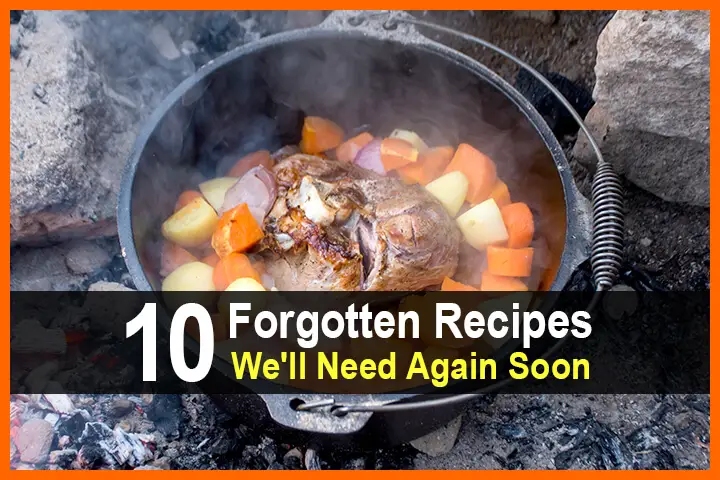Estimated reading time: 16 minutes

Our pioneer ancestors were a diverse collection of immigrants who not only brought their language and customs to early America, but also a history of recipes and cooking styles designed for the challenges of unknown and wild environments. They applied cooking and recipe concepts to the wild game, plants, and ingredients they could forage and hunt.
But as vital as many of these recipes were, many have been lost to time. And you won’t find a lot of these recipes calling for truffles, saffron, or coconut oil in a pioneer cookbook.
What you will find are recipes with few and basic ingredients cooked simply and often over an open fire. It’s a style of cooking worth mastering, and the ability to understand the concept of how and why a recipe works empowers you to improvise when ingredients are few and far between.
And few and far between is occurring more and more in countries around the world, including the United States. For a while there, egg prices almost seemed reasonable again, but within weeks they went back up to $4 or $5 dollars a dozen.
The supply chain issues that were so apparent during the pandemic are continuing thanks to new challenges such as the Baltimore bridge collapse and Houthi rebels threatening shipping in and across the Red Sea. In the meantime, dictators continue to rattle the nuclear saber from Russia to North Korea to Iran.
The list goes on, but food insecurity for many people around the world is growing, and a time may come when the basic recipes that sustained pioneers, fed families through world wars, and kept people alive during the depression become a necessary lifestyle choice.
Want to save this post for later? Click Here to Pin It On Pinterest!
Revisiting the Forgotten
The origin of these recipes go back to the early American colonists and continue to the pioneers who crossed the great plains and the Rocky Mountains including wagon train recipes, cowboy recipes, and recipes that emerged during the great depression and countless wars.
We’ll cover a few recipes in detail, but we’ll also go over information related to primitive cooking techniques and food preservation practices.
Pioneer Cooking Styles

The primary heat for cooking in the past was the open fire. It may become the main way to cook in the event of grid failure or catastrophic disaster.
Open fire cooking is very effective and an obvious solution, but it has its share of challenges. The biggest challenge is managing and moderating the heat. Foods can and will quickly burn over an untended or unmanaged fire. On the other hand, all fires eventually go out and food can remain uncooked or partially cooked.
The best solutions are usually fires that either have a distribution of heat with one side of the fire burning hot while the other side of the fire simmers with burning coals.
Other heat moderation methods include cooking hardware that keeps pots, pans, and food in general some distance from the fire so the heat remains steady but not intense.
Think About the Design of Your Fire
Our tendency when cooking outdoors is to throw some wood on the ground and build a fire and then think about what we need to cook. If you think about the various fire designs and build a fire designed for the recipe, you’ll increase your chances of success.
Here are some links to various articles and videos that cover fire building and designs for a large number of cooking styles and recipes.
Cast Iron is Key

Regardless of the design of a fire, the utensils, pots, and pans used for rustic or primitive cooking have a lot to do with the success of any recipe. Whether you’re cooking over an open fire or have the luxury of a wood-burning cookstove, the cooking utensils can make all the difference.
While any type of pot or pan can be used for wood-fired cooking, cast iron is best. It’s heavy metal and thick, and the combination not only distributes heat evenly but prevents food from burning to some degree. It also retains heat well to keep food warm when removed from the fire.
Forgotten Recipes

We’re going to outline some basic recipes for pioneer cooking, but what’s most important is that each one defines a cooking method or style that can be adapted to a variety of ingredients or alternative recipes.
The important thing is to understand the concept of how the recipe ingredients and cooking style work together to make a successful meal, whether it’s a simple loaf of bread or a complex stew.
Pioneer Breakfast Recipes
The easiest breakfasts were often defined by things as simple as eggs and bacon, but there are some variations that combine ingredients to enhance both taste and nutrition. Here are a couple that fall in the category of “one-pot” meals that made breakfast easy and somewhat foolproof.
Soda Biscuits and Gravy

This biscuit recipe uses baking soda and a splash of vinegar to replace the rising action of baking powder. It was a common pioneer biscuit recipe and was often served with a gravy made from pork sausage or bacon.
The key to this recipe is to carefully measure the amount of baking soda. Too much and the biscuits will taste very bitter. Not enough and the biscuits will fall flat.
Soda Biscuits Recipe
Ingredients:
- 3 ½ cups flour
- Milk
- 1 tsp baking soda
- 1 tsp
- 1 tsp salt
Directions:
- Drop all of the flour into a bowl and slowly add one tablespoon of milk at a time until you form a stiff dough.
- In a separate bowl, dissolve the baking soda in another tablespoon of milk and then mix in the vinegar and then add and knead it into the dough.
- Mix in the salt and roll out the dough to about ½ inch thick.
- Cut circles out using the top of a glass or cup.
- Place the biscuits in a Dutch oven and bake until the sides and top are brown.
- Place biscuits in a bowl and top with gravy and serve.
Sausage or Bacon Gravy
The drippings and bits of sausage or gravy were combined with flour and water to make a smooth, creamy gravy that was often served over soda biscuits.
The key to this recipe is to make a roux from the flour and either bacon grease or sausage grease before stirring in the milk.
Sausage Gravy Recipe
Ingredients:
- 6 sausages or 6 rashers of bacon
- ½ cup of flour
- ½ cup of milk (add more as the gravy thickens until you get the desired consistency of a gravy)
- Salt and pepper to taste
Directions:
- Fry the sausage or bacon until cooked
- Remove the sausage or bacon and chop up and add them back to the grease in the pan.
- Stir in the floor over medium heat until it starts to thicken.
- Add more milk as the flour thickens stirring constantly.
- Taste and sprinkle with salt and pepper until you have the taste you want.
- Serve over biscuits
Dutch Oven Quiche

Real men do eat quiche and often did. Quiche is nothing more than a baked mix of vegetables and meats held together with a batter made predominantly from eggs.
The key to this recipe is to cook it gently. The eggs are fragile and when exposed to high heat or long duration heat they can and will burn.
Dutch Oven Quiche Recipe
Ingredients:
- 12 eggs
- 2 cups half and half (milk can be substituted if half and half not available)
- 2 cup cheese (grated (cheddar cheese, swiss cheese or mozzarella))
- 4 tbsp parmesan cheese (optional)
- Salt & pepper to taste
- 2 cup optional ingredients (See Below)
Optional ingredients:
- Cubed ham or crumbled cooked bacon
- Chopped broccoli
- Chopped tomatoes
- Sliced onions or green onions
- Chopped asparagus
- Cooked cubed potato
Directions:
- Prepare about 24 coals
- In a large bowl whisk together the milk, egg, cheese and salt & pepper.
- Stir in any additional ingredients.
- Pour the egg mixture into your pre-heated Dutch Oven
- Place 8 coals underneath and the remainder on lid
- Cook for 30-45 minutes or until it is cooked through.
Pioneer Lunch Recipes
Lunch was usually a busy time, but the amount of energy expended by our pioneer ancestors required a break for lunch. The meals were usually simple and either easy to prepare or started early in the day and left to simmer until lunch.
Open fire cooking was the preferred method because a simple fire on the ground was easy to make and quick to burn hot enough for cooking.
Hobo Sandwiches

Hobo sandwiches use something called a pie iron to hold two pieces of bread enclosed in a fold of metal that is then placed directly over or into a fire to toast the bread and heat any ingredients in the sandwich.
The pie iron has a handle protruding from the enclosure so it can be held over the fire or the iron end simply placed in the coals. They’re called Hobo sandwiches because this was a popular cooking method used by hobos during the Great Depression.
The key to cooking a sandwich in a pie iron is to oil the surface of the two slices of the bread with butter, oil, lard, tallow or any other kind of fat. This will prevent the bread from sticking to the metal and help toast it.
Hobo Sandwich Recipe
Ingredients:
- 2 slices of bread
- 1 slice of cheese (any kind)
- Meat or fish (your choice)
- Butter, oil or some kind of fat
Directions:
- Slather some butter or oil on one side of each slice of bread
- Place on slice of bread buttered side down into the pie iron
- Build your sandwich
- Top with the other slice of buttered bread
- Put together the pie iron and place or hold over the fire turning from time to time for about 3 to 4 minutes.
- Open the pie iron and when the breaded is nicely toasted you’re done.
Cowboy Kebabs

Every culture around the world has their variation on kebabs. They’re basically meat on a stick although vegetables were often skewered on the kebabs as well.
The key to kebabs is to make sure the meat is of uniform size and to turn frequently so everything is cooked through.
Cowboy Kebab Recipe
Ingredients:
- Chunks of meat all cut into cubes of equal size. About 1-inch square is a good average
- Chunks of vegetables like onion, pepper, or tomatoes also about 1-inch square
- Salt and pepper
Directions:
- Skewer the meat and vegetables on long wooden sticks or metal skewers
- Try to alternate meat and vegetables on the skewers
- Don’t push the meat and vegetables together too tightly but you want them close enough that they won’t spin when you try to turn the kebabs
- Place on the grill and cook about 2 to 4 minutes a side depending on the heat from your fire
- Keep turning until the meat is browned.
- Cut open a piece of meat from the middle of the skewer to check for doneness and return to the grill if they need more time.
Pioneer Dinner Recipes
Dinner was often the most anticipate meal of the day and on some days, it was the only meal that some people had to eat. It was usually a variety of courses with a protein like meat or fish, some vegetables, and a bread or bread variation. Starches like potatoes or rice were also prepared if available.
In many instances the courses were combined in a stew, casserole or pie. This provided a good assortment of nutrition in an easy to make and serve meal.
Bannock Bread

Bannock bread is also known as frying pan bread because it’s cooked in a frying pan. Ovens were hard to come by on many occasions and Bannock bread allowed someone to make bread with the most basic cooking setup.
The key to bannock bread is a cast iron frying pan. The cast iron distributes the heat evenly and protects the bread from burning on the bottom to some degree.
Bannock Bread Recipe
Ingredients:
- 2 1/2 cups flour
- 2 tsp baking powder
- 1/2 tsp sugar
- 1/2 tsp salt
- 3 tbsp oil (you could use olive, coconut, lard, or butter
- 1 cup water
Directions:
- Combine all of the ingredients in a bowl and stir and mix until you have a batter-like dough
- Scoop into a buttered or oiled cast iron frying pan
- Place on a grate over coals for about 10 minutes. Lift the bannock after about 5 minutes to check for browning or burning
- Using a spatula or large knife, flip the bannock to cook the other side
- Continue to bake for another 10 minutes until both sides are evenly browned
Perpetual Stew

Perpetual stew is a constantly simmering pot of soup. It was popular in cowboy camps and wagon trains. The camp cook would add vegetables, meat bones and meat trimmings as each meal was prepared and the combined ingredients would stew in a large cauldron suspended over a fire over days and days.
It was largely designed as a way to snack with a quick dip of cup into the stew for an anytime meal. At other times, the cook would add more robust ingredients and some bread or biscuits on the side and the stew would become the main meal at dinner.
The key to a perpetual stew is a large, cast iron cauldron suspended over a steady fire to keep the pot at a gentle boil at all times.
Perpetual Stew Recipe
Ingredients:
- Water. Avoid well water which can have an iron aftertaste or tap water that can have residual flavors from fluoride to chlorine. You can filter water if you like but spring water is best.
- Bones. Beef bones, soup bones, pork bones and poultry carcasses.If you want a fish broth you can use fish bones or fish heads or shellfish like crawfish, shrimp, clams, and mussels.
- Vegetables. This could be any combination of what you have on hand including Onions, Carrots, Celery, Parsnips, Rutabagas, Kale and Green onions.
- Seasonings. Season to your taste. This includes salt, pepper, bay leaves, herbs like basil or thyme.In the wild you can add dandelion greens, plantain leaves, clover, or purslane.
Directions:
- Add the water to a cauldron until the pot is 2/3’s full.
- Bring to a boil and add the bones and vegetables.
- As the fire burns down try to keep it at a heat level that maintains a gentle boil in the cauldron.
- Taste the stew after an hour or two and season to suit your taste. Remove the bones and discard.
- To replenish the stew -add more water, vegetables and meat bones or meat scraps.
- Readjust the seasonings and continue with this replenish cycle over the days and weeks.
Additional Forgotten Recipes
Pioneer Food Preservation/Cooking Methods

Just as important as the forgotten recipes are some primitive techniques to not only preserve food, but cook it for a meal. Anytime someone jerked some venison, smoked some fish, or fermented some cabbage, it found its way to the table.
It also allowed our pioneer ancestors to preserve the excess at a time when refrigerators and freezers were few and far between.
There are numerous recipes for each one of these food preparation and preservation techniques, so we’re going to feature key links to articles and videos that cover the concepts and recipes in more detail.
Jerky – Meat and Fish
Smoked Meats and Fish
Fermented Vegetables
Dried Fruits
Canning and Preserves
Like this post? Don’t Forget to Pin It On Pinterest!

Read the full article here




